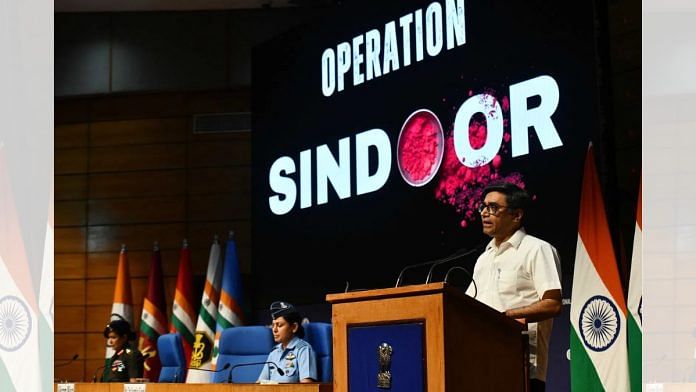Thank you dear subscribers, we are overwhelmed with your response.
Your Turn is a unique section from ThePrint featuring points of view from its subscribers. If you are a subscriber, have a point of view, please send it to us. If not, do subscribe here: https://theprint.in/
How did India and Pakistan, two nuclear armed countries, perform—in the 4-day high intensity conflict that that included shooting missiles, drones, and artillery and mortar exchanges across the border—in coordinating their respective strategic communication with evolving facts on the ground to shape international public perceptions?
India launched Operation Sindoor on the night of May 6-7 with a clearly delineated mission to destroy terrorist headquarters and training camps and project deterrence against non-state actors. The immediate objective was to hold backers of the “barbaric terrorist attack in which 25 Indians and one Nepali citizen were murdered” accountable.
The succinct press release, put out immediately following the strikes, told the world that the strikes were “focused, measured, and non-escalatory in nature” and did not target Pakistan’s military facilities.
As the world woke up to images of destroyed targets on television and in social media, the hybrid conflict in the information space was joined by Indians and Pakistanis.
Early in the morning, Pakistan’s Inter-Services Public Relations (ISPR) had already got into top gear, pushing its propaganda to representatives of global media in Islamabad.
While ISPR could not dismiss the images of the total decimation of the nine terrorist headquarters and training camps from POK in the north to Bahawalpur in Pakistani-Punjab, the masters of propaganda hooked their manipulative strategic communication on two prongs. The first prong was that Pakistan Air Force had successfully countered an Indian air attack by downing five jets, including two advanced Rafales, using beyond the visual range Chinese PL15 fired from Chinese J-17, and the second prong was that civilians had died in Indian strikes.
A strategic affairs expert with Observer Research Foundation, knowledgeable of ISPR propaganda, Sushant Sareen, appearing on television channels, called for multiple press briefings to counter information deficit on the Indian side.
Indeed, Indian strategic communication was slow to start, but once it got going, the unified military and diplomatic was able to succeed in what scholars describe as non-manipulative strategic communication that was in alignment with facts on the ground. On the Indian side, misinformation only came from cacophonous television channels and social media warriors.
In Indian press briefings led by Vikram Misri, secretary of the foreign affairs ministry, and assisted by two women officers, Col Sofiya Qureshi and Wing Com Vyomika Singh, read out prepared press statements that were factual and measured while not revealing tactical information. The messaging never lost focus of the core non-escalatory mission and avoided inflammatory nationalistic rhetoric.
The Pakistani claim that it shot down Indian jets was uncritically reported in the international media, quoting two anonymous American officials lending credence. In the contemporary hybrid media environment, propaganda leverages virality built on cross-referencing without independent verification.
The jet combat between the air forces of the two countries was conducted without crossing the international boundary and LOC. The PAF’s claim of beyond visual range air-to-air missile kills was not backed by either evidence of multiple downed jets or digital data of locked radars. It was mostly a conjecture based on a picture of an aircraft that crashed in Srinagar.
As Indian spokespersons, including seasoned diplomats Shashi Tharoor and Jawed Ashraf, appeared in the global media to tell the world about the counterterrorism strikes and Pakistani mastery of denial and delusion. When they were asked about downed jets and dead civilians, they brought back focus in the global media on terrorist targets and dead terrorists and called on Pakistan to take the off-ramp. They came prepared with facts, including pictures of Pakistan military officers in uniform funeral of dead terrorists.
As Pakistan chose to escalate with missiles, drones, and artillery exchanges on the Line of Control, Indian air defense got into action and shot down most of the attacks coming from Pakistan. While ISPR in its press briefing and through its surrogates in the international media kept pushing misinformation and disinformation on its imagined success in striking Indian military bases, downing aircraft, and killing soldiers. The Indian press briefings conducted by the trio of Misri, Qureshi, and Singh stuck to facts in a measured tone while highlighting that Pakistan was targeting civilians, temples, and gurudwaras.
As the Pakistani drones and missiles failed to get through the Indian air defenses, ISPR’s manipulative communication in press briefings became more and more bizarre with morphed pictures of destroyed Indian bases, jets, and cities.
On the evening of May 9, Pakistan fired a Fatah II ballistic missile at New Delhi, the national capital. The missile was intercepted, but the firing of a ballistic missile escalated the conflict. India responded by destroying Pakistani air defense and in coordinated attacks on 12 Pakistani air bases, destroying airstrips, hangars, command centers, and drone launch pads.
The severity of the loss forced Pakistan’s DGMO to call the Indian counterpart and ask for a ceasefire, to which India agreed. Thus, in the intense but short-lived multidomain conflict, India succeeded in projecting deterrence that showed superior military tactics and non-manipulative strategic communication that was aligned with facts and withholding tactical information.
Anup Kumar is professor of communication in the School of Communication at the Levin College of Public Affairs and Education, Cleveland State University, Ohio, USA
These pieces are being published as they have been received – they have not been edited/fact-checked by ThePrint.


